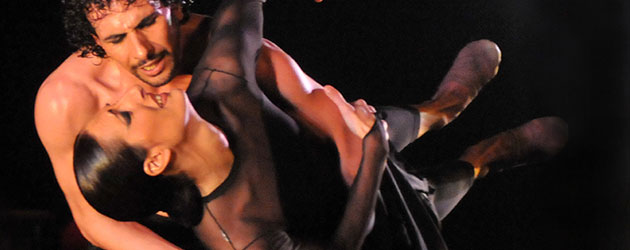Text: Estela Zatania
Photos: Ana Palma
Monday, March 4th, 2013. Jerez de la Frontera
Special 17th Festival de Jerez – All the information
LAS MUJERES DOMINAN LA UNDÉCIMA JORNADA DEL FESTIVAL DE JEREZ
ÚRSULA LÓPEZ “LA OTRA PIEL”
Teatro Villamarta, 9.00pm
Monday evening at the Villamarta theater, the Festival de Jerez gave us the chance to see another facet of current flamenco in the person of Cordoban dancer Úrsula López, who also is credited as director and choreographer of her new work “La Otra Piel”.
The show is a buffet that goes from the most contemporary dance, to the most traditional flamenco, all wrapped and presented in an admirable package of high quality in all its elements. Castanets are used a great deal, and without apologies; for years this traditional accessory had been considered as corny as polkadots (which are also making a comeback). After a slow beginning, the luminous fandangos de Huelva of singer Jeromo Segura call us to attention. The power of Jesús Méndez’ tonás leads into siguiriyas rhythm without guitar as the basis for an avant-garde choreography. Liviana and serrana with music attributed to guitarist Javier Patino, with Jeromo and Londro singing, and the choreography doesn’t stray from a strictly contemporary line with barefoot women and bare-chested men.
Úrsula wears red for cantinas, now in a more conventional vein. This versatile woman changes register with the greatest of ease. Tino van der Sman’s lovely arrangement of Albéniz’ Asturias is danced by Cristián Lozano, and a tribute to Enrique Morente takes the form of a modern dance by Úrsula and her sister Tamara in which the creative genius of Andrés Marín in the choreography is on display. After a tientos-zambra by Méndez, there was a bulerías arrangement with the entire company which served as an introduction for the impressive caña with unusual harmonies, once again with the music of Van der Sman, danced by Úrsula. Dressed in white with bata de cola and shawl, the piece gave new life to a cante that tends to get moldy from disuse, and this turned out to be the highlight of the show.
MARI PEÑA, LA TANA “DE UTRERA A TRIANA”
Ciclo: Los conciertos de palacio
Palacio Villavicencio, 7pm
There are about forty kilometers, some 25 miles, from Utrera to Triana, and about 100 kilometers, 60 miles, from Triana to Jerez. But those short distances, which a hundred years ago were much less manageable when flamenco was rapidly developing, reflect recognizably different kinds of flamenco. You could write volumes comparing the flamenco of Seville province to that of Cádiz province, the interior versus the coast. We’re all one big flamenco family, but one of the most enriching characteristics of this genre is its capacity to adapt to different ways of expressing shared emotions.
In the cozy Palacio Villavicencio, with the ambience of a flamenco “peña” minus the bar, Mari Peña de los Peña Pinini and Tana, daughter of singer Herminia Borja, dressed in black like two flamenco nuns, gave their take on flamenco. It was almost like a continuation of what we’d heard a few days earlier in this same spot with singers Márquez el Zapatero and Antonio el Carpintero, also from Seville province – between both recitals a faithful portrait was painted of cante as seen “up north”. The laidback rhythm of bulerías, the more clippy soleá approaching bulería por soleá, the magic these singers work turning popular music into flamenco or the fandango por soleá as an exotic form that gives flamenco energy through a rhythmic backdrop.
And Mari, sweetly sad for tientos, a form the singers of Utrera raise to a high level thanks to the legacy of Gaspar de Utrera, tangos de Triana in the style of Perrate and cantinas with the aroma of Lebrija and Utrera. And the controlled aggressiveness of Tana with her bulerías outbursts, her taranta and her soleá. And of course the guitar of Antonio Moya, who knows these forms of Utrera, Lebrija and Seville inside and out and gave the perfect feel to each cante.
MANUELA RÍOS “CONSUELO DE PENAS”
Ciclo: Muy flamencos
Sala Compañía, 12 midnight
The evening came to an end in the Sala Compañía with a dance show within the series “Muy flamencos”. We hear the famous guitar-playing of Morón guitarist Diego del Gastor, with the voice of Fernanda de Utrera to stop the mental clock and situate us in the recent past of flamenco, which is the natural habitat of dancer Manuela Ríos.
Manuela has a special spark and controlled strength and intensity. She risks just enough, and tends not to miscalculate. Her carefully selected back-up was comprised of singers Moi de Morón and Pepe de Pura, in addition to María Vizárraga who delivered a rousing bulerías solo, and the guitars of Ramón Amador and Miguel Iglesias. A capella singing, but this time it wasn’t tonás, but granaína, followed by two guitar solos adorned with subtle sideline dancing. A long bulería solo by Cristina Hall, also unaccompanied, should have been half as long, and was the only weak spot in the show. The Tarara danced by Manuela and Hall was interesting, but the centerpiece turned out to be Manuela’s soleá with the force of her temperament that doesn’t seem faked.
“Consuelo de Penas” is an irresistible flamenco show with the aroma of rosemary and sage, apt for those who long for flamenco that breathes real emotions.
